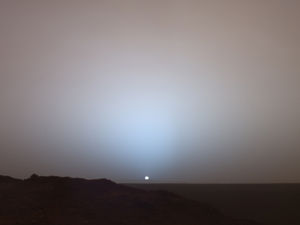Difference between revisions of "Atmosphere"
(Replaced concentrations of gases with more modern data from Curiosity rover) |
m (Fixed an error in my previous edit) |
||
| Line 5: | Line 5: | ||
Composition of Mars atmosphere by volume<ref>[https://science.sciencemag.org/content/341/6143/263 Abundance and Isotopic Composition of Gases in the Martian Atmosphere from the Curiosity Rover]</ref><ref>[http://www.daviddarling.info/encyclopedia/M/Marsatmos.html Water and trace gases based on table from David Darling Space Encyclopedia]</ref> | Composition of Mars atmosphere by volume<ref>[https://science.sciencemag.org/content/341/6143/263 Abundance and Isotopic Composition of Gases in the Martian Atmosphere from the Curiosity Rover]</ref><ref>[http://www.daviddarling.info/encyclopedia/M/Marsatmos.html Water and trace gases based on table from David Darling Space Encyclopedia]</ref> | ||
{| | {| | ||
| − | | | + | |Percentage |
|Gas | |Gas | ||
|- | |- | ||
Revision as of 18:19, 2 June 2019
The Atmosphere of Mars is not breathable. The pressure is too low, and there is too little oxygen. And yet, it gives Mars something that makes it the most habitable of all planets in our solar system, except Earth of course. It provides valuable chemicals, and it forms a visible sky, mostly from dispersed dust.
Composition (gaseous parts)
Composition of Mars atmosphere by volume[1][2]
| Percentage | Gas |
| 96.0% | Carbon dioxide (CO2) |
| 1.93% | Argon (Ar) |
| 1.89% | Nitrogen (N) |
| 0.145% | Oxygen (O2) |
| 0.09% | Carbon monoxide (CO) |
| 0.03% | Water vapor (H2O) |
| trace | Neon (Ne), Krypton (Kr), Xenon (Xe), Ozone (O3), Methane (CH4) |
Mars surface pressure
1-9 millibars (depending on altitude).
References
| This article is a stub. You can help Marspedia by expanding it. |







